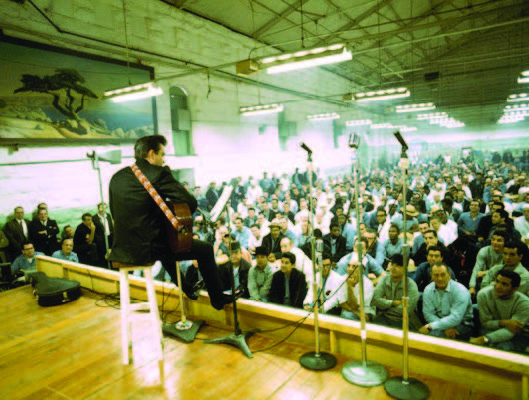Silver State, Gold Records
January – February 2015
Nevada’s musical legacy stretches back more than a century.
BY NELLIE DAY
Nevada leaves a lasting impression on people for many reasons. Case in point: Nevada has been a keen source of musical inspiration for more than a century. Just ask Dan Reynolds, lead singer of Imagine Dragons—an American indie rock band from Las Vegas—who has admitted there would be no band without Sin City. Or Brandon Flowers, frontman of Las Vegas American rock band The Killers, who told attendees at the 2013 Life is Beautiful festival that many of the band’s songs took place on the very Downtown Las Vegas streets they were standing on.
Both bands also used Las Vegas as inspiration for some of their latest music videos. Imagine’s “Demons” juxtaposes footage from a concert the band played at The Joint inside the Hard Rock Hotel and Casino with a series of touching vignettes about supposed audience members. The Killers’ “Shot at the Night” is filmed entirely in Las Vegas. It prominently features the Cosmopolitan, as well as parts of Downtown Las Vegas.
LOVE FOR THE RURALS
 While Las Vegas, Reno, and Lake Tahoe have certainly nabbed their fair share of musical notoriety, what’s even more astounding is the number of smaller towns and lonesome Nevada highways that have also managed to grab the spotlight for a lyric or two. From Scott Joplin to Johnny Cash, it seems everyone has a song—and a soft spot—in their hearts for the Silver State.
While Las Vegas, Reno, and Lake Tahoe have certainly nabbed their fair share of musical notoriety, what’s even more astounding is the number of smaller towns and lonesome Nevada highways that have also managed to grab the spotlight for a lyric or two. From Scott Joplin to Johnny Cash, it seems everyone has a song—and a soft spot—in their hearts for the Silver State.
1907: It all started when Scott Joplin named his ragtime composition “Searchlight Rag” after the Nevada town. His colleague and fellow composer Tom Turpin had regaled Joplin with stories about growing up in Searchlight and his many prospecting adventures in the unincorporated southern Nevada town.
1964: Songwriter Steve Gillette’s little sister Darcy had an unfortunate run-in with a horse when she was 12. The incident led to the song “Darcy Farrow,” in which a young girl suffers a fatal fall while riding her pony. The song evolves into a tragic love story that spans the Carson Valley. Darcy’s bright eyes are compared to the “pretty lights” out in Yerington, her beauty so vast, they still sing her praises in Truckee and Virginia City. The song was co-written with Tom Campbell and most famously performed by John Denver on his “Rocky Mountain High” album.
“Darcy Farrow”
Where the Walker runs down to the Carson Valley plain, There lived a maiden, Darcy Farrow was her name
The daughter of old Dundee and fair was she And the sweetest flower that bloomed o’er the range.
Her voice was sweet as the sugar candy Her touch was as soft as a bed of goose down.
Her eyes shone bright like the pretty lights That shine in the night out of Yerington town.
They sing of Darcy Farrow where the Truckee runs through They sing of her beauty in Virginia City too.
1971: Nevada’s famous for its long, open highways. Most coast-to-coast truckers know this to be true. They also know life on the road can be lonesome, a feeling the driver in Lowell George’s “Willin’” is all too familiar with. While trying to get his mind off “Alice, Dallas Alice,” the poor soul gets caught up in smuggling cigarettes and other unscrupulous items from Mexico. The trucker keeps his load moving, hoping to evade the law as he drives from Tehachapi to Tonopah. The song originally appeared on the debut album for Little Feat, where George served as guitarist and singer. It was also performed by Linda Ronstadt on her 1974 album, “Heart Like a Wheel.”
“Willin’”
I’ve been from Tuscon to Tucumcari
Tehachapi to Tonopah
Driven every kind of rig that’s ever been made
Driven the back roads so I wouldn’t get weighed
1978: Though the protagonist in Jimmy Webb’s “Highwayman” takes on four different reincarnations by the time the song is through, one thing is for sure: he’s a traveling man. In addition to being a highwayman, sailor, and starship captain, our traveler also turns out to be a construction worker in Boulder City, where he works on Hoover Dam. Glen Campbell recorded the song in 1978, but its real claim to fame happened in 1984 when Johnny Cash, Waylon Jennings, Willie Nelson, and Kris Kristofferson recorded “Highwayman.” Each performer adopted one of the four personas; Jennings served as our beloved dam builder. The quartet soon became known as The Highwaymen, famous for a sound known as outlaw country.
“Highwayman”
I was a dam builder across the river deep and wide
Where steel and water did collide
A place called Boulder on the wild Colorado
1996: Johnny Cash was a man known to enjoy the road. That good time didn’t stop with The Highwaymen. It continued right through 1996 when he recorded his rendition of “I’ve Been Everywhere.” By the time that track was laid down the song had, in fact, been everywhere. It began its journey in 1959 when the original version, which featured a list of Australian towns, was recorded by Geoff Mack. Hank Snow adapted it for American audiences in 1962. Today, the catchy trend of listing well-known cities, states, provinces, and other landmarks has resulted in upwards of 20 covers.
The narrator in the American version is hitchhiking to Winnemucca when a kind trucker offers him a ride. We soon find out this isn’t his first brush with Nevada, as he regales the driver with a list of his cities past, including Reno.
“I’ve Been Everywhere”
I was totin’ my pack along the dusty Winnemucca road,
When along came a semi with a high an’ canvas-covered load.
“If you’re goin’ to Winnemucca, Mack, with me you can ride.”
And so I climbed into the cab and then I settled down inside.
 1998: Center Divide’s entire debut album, “Lovelock to Winnemucca,” is inspired by the band’s experiences out West. The album opens with “Lovelock,” a song about a heartbroken man on a lonely road heading to Winnemucca. Like some of the travelers mentioned above, he finds himself on a highway that stretches for miles, providing too much time for a guy to contemplate a broken heart. As one might predict, the album closes with “Winnemucca.” Though the city is never mentioned by name, it’s assumed that when the narrator encounters the forlorn traveler who whizzes by, they have indeed reached their destination.
1998: Center Divide’s entire debut album, “Lovelock to Winnemucca,” is inspired by the band’s experiences out West. The album opens with “Lovelock,” a song about a heartbroken man on a lonely road heading to Winnemucca. Like some of the travelers mentioned above, he finds himself on a highway that stretches for miles, providing too much time for a guy to contemplate a broken heart. As one might predict, the album closes with “Winnemucca.” Though the city is never mentioned by name, it’s assumed that when the narrator encounters the forlorn traveler who whizzes by, they have indeed reached their destination.
“Lovelock”
If you ever drive
From Lovelock to Winnemucca,
It’s a good idea to pack your cares along
The desert’s big and wide
Those mountains stand far apart
There’s a whole lotta room to lose
a broken heart

2006: The city that serves as Railroad Earth’s fourth album title is no stranger to the band. The newgrass sextet usually spends the night in Elko after driving to or from California. The band stated it was always grateful the rooms in Elko were cheap, the bars were 24 hours, and the casino, well, existed. You would be too if you were making the 7.5-hour trip from the rocky, coastal destination of Devil’s Slide.
“Elko”
Been a long hot desert ride Wasatch, Bear River, Devils Slide and Elko
Poor boy you’re bound to cry
 2007: There is no love lost for Lovelock in the first half of Hot Buttered Rum’s “Limbo in Lovelock.” The narrator’s car has broken down, he’s lovelorn and to top it all off, it’s snowing. But sometimes it’s the little things in life that bring great pleasures. Like a burger, or a few smiles here and there. By the end of the song, the narrator has found both at the Cowpoke Café. The final lyrics are based on the band’s actual experience in Lovelock. Though the restaurant’s sign advertised culinary “special of the day,” the five members left convinced it was the teenage employees’ smiles that were the real specials that day. The song appeared on the band’s 2007 album, “Live in the Northeast.”
2007: There is no love lost for Lovelock in the first half of Hot Buttered Rum’s “Limbo in Lovelock.” The narrator’s car has broken down, he’s lovelorn and to top it all off, it’s snowing. But sometimes it’s the little things in life that bring great pleasures. Like a burger, or a few smiles here and there. By the end of the song, the narrator has found both at the Cowpoke Café. The final lyrics are based on the band’s actual experience in Lovelock. Though the restaurant’s sign advertised culinary “special of the day,” the five members left convinced it was the teenage employees’ smiles that were the real specials that day. The song appeared on the band’s 2007 album, “Live in the Northeast.”
“Limbo in Lovelock”
Well just outside of nowhere
Mile marker 105 You’ll find yourself in Lovelock where the game is to stay alive
Get yourself a burger down at the Cowpoke Café
Where the gals have quite a smile, it’s the special of the day
2007: Dance Gavin Dance was inspired to name its debut full-length album “Downtown Battle Mountain” after stopping in the unincorporated town between Winnemucca and Elko. The post-hardcore band had observed that the entire downtown area of Battle Mountain consisted of one gas station and suddenly, an album title was born. The tiny town of less than 4,000 received a second nod in 2011 when Dance Gavin Dance released its fourth album, “Downtown Battle Mountain II.”


